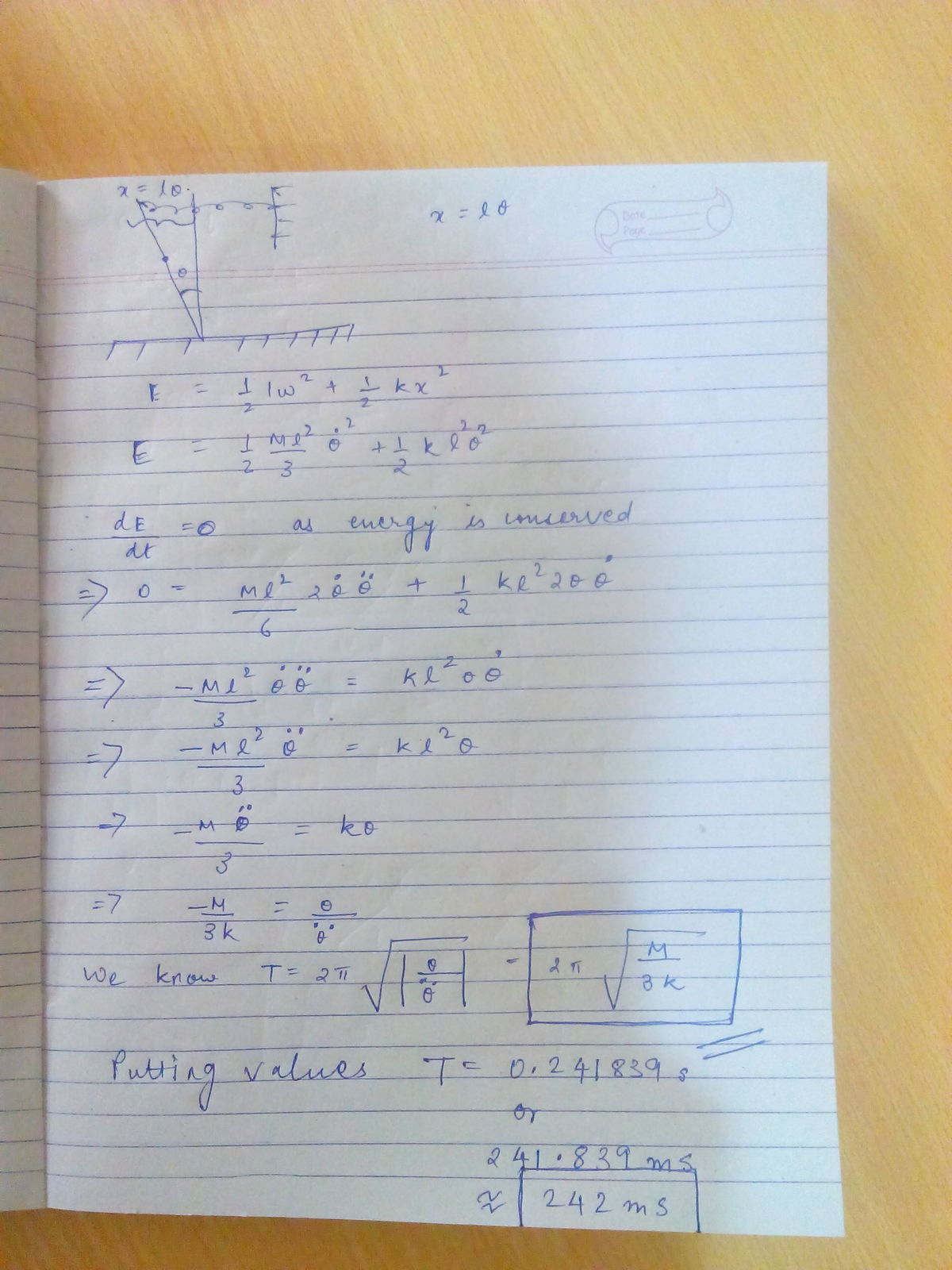Springy rod
A 2 . 0 0 kg rigid rod with length L is hinged at one end to the floor, so it can freely rotate in a certain plane perpendicular to the floor. A spring ( k = 4 5 0 N/m ), which stretches in the same plane, is attached to the free end of the rod as well as a nearby wall. When the rod is straight up (perpendicular to the floor), the spring is not stretched and is perpendicular to the rod. If the rod is rotated very slightly (such that the effects of gravity are negligible) and released, what is its period of oscillation in ms (rounded to the nearest integer)?
The answer is 242.
This section requires Javascript.
You are seeing this because something didn't load right. We suggest you, (a) try
refreshing the page, (b) enabling javascript if it is disabled on your browser and,
finally, (c)
loading the
non-javascript version of this page
. We're sorry about the hassle.
4 solutions
it's 241.83 bro !
plz can u explain me the line """""This means that this situation is equal to a situation in which a point size mass equal to""".....
How we treat it as M/3
@Prem Kumar Elegant solution done same way.
The length of the rod is not needed to solve the problem in the approximation that the amplitude of oscillations is very small (as noted by the words "very slightly"). To begin the problem, note that the moment of inertia of the rod about the hinge is I = 3 1 M L 2 = 3 2 L 2 . Next, using the approximation that the amplitude of oscillations is small, the extension of the spring is x = L θ (this approximation assumes the stretching distance is close to straight). Now, we use torque to equate two quantities:
τ = I α = r × F
We care about the magnitude of the force, so we simplify the cross product into F L s i n θ = ( k L ) L sin θ = k L 2 sin θ (magnitude of r is L ). Since the value of θ is small, we can make the approximation sin θ ≈ θ . Since the force is a restoring force (it opposes the direction of the displacement from the equilibrium position), we must also place a negative sign on the right side on the equation. Finally, replacing ω with d t 2 d 2 θ and I with 3 2 L 2 :
3 2 L 2 d t 2 d 2 θ = − k L 2 θ
⇒ d t 2 d 2 θ = − 2 3 k θ
Notice that L cancels out, and that the expression resembles one that follows Hooke's law. Thus, the solution to the differential equation yields the angular frequency to be ω = 2 3 k . Since ω = 2 π f = T 2 π , the period is T = 2 π 3 k 2 = 2 π 3 ( 4 5 0 ) 2 ≈ 0 . 2 4 2 s = 2 4 2 m s .
If we were not to consider gravity, it should be stated in the problem, no?
Log in to reply
What effect, exactly, would gravity have on the situation? Of course, there are many assumptions in this problem, such as the hinge being frictionless, the spring being massless, etc. But since the amplitude of oscillation has no quantitative value, I don't see how gravity would be something to consider. Please feel free to explain and prove me wrong though, and I will edit accordingly. :)
Log in to reply
This is how I interpret the problem:

The orange line represents the rod and the blue line represents the spring.
Both the forces certainly produce a torque so the L remains and doesn't cancel out.
Log in to reply
@Pranav Arora – Your interpretation is completely correct, but if the rod remains close to vertical, the gravitational force will produce ≈ 0 torque. Sure, it seems it would have an effect on the problem, but this would only complicate the problem. This kind of problem is aimed at creating an expression resembling Hooke's law, which provides a simplistic model of harmonic motion (just like about every other assumption in the problem). I shied away from listing assumptions in fear of giving too many hints.
I apologize, I made a mistake in the second paragraph. I meant to say that the cross product can be simplified as follows:
∣ ∣ ∣ r × F ∣ ∣ ∣
= ∣ ∣ ∣ r ∣ ∣ ∣ ∣ ∣ ∣ F ∣ ∣ ∣ sin 9 0 ∘
= ( L ) ( k L θ ) ( 1 ) = k L 2 θ
As a result, the comment about approximating sin θ ≈ θ is irrelevant.
Very slightly doesent state dt yu dnt have to take gravity into consideration.......its fine if yu say sinx=x wen x<<1degree......yu have to find out de length of de rod.....fr dt u need to to write both force equation and torque equation ....werever der is x[extn of spring] substitute it as l[theta].....solve both to find length.....

Moment of inertia of such a rod is equal to 3 M L 2 This means that this situation is equal to a situation in which a point size mass equal to 3 M is pivoted at a distance of L from the floor. IF WE IGNORE GRAVITATIONAL PULL, then using M = 3 2 k g and K = 4 5 0 N / m we can find the value of time period.
Answer will be 241.7 ms